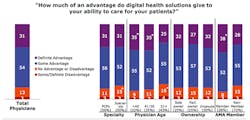Hospitals Have a Smartphone Problem
In just a few short years, we’ve witnessed the smartphone’s rise from bleeding-edge innovation to household fixture. We’ve watched it permeate every industry, establishing itself as essential to how we interact and operate, to the point where we’ve come to define our times by it — this is the smartphone age.
But mobile technology’s diffusion into the mainstream hasn’t been uniform. Some industries have greeted the mobile revolution with open arms, while others have resisted this paradigm shift (to varying degrees of success).
The healthcare sector falls somewhere in between, and that’s a cause for serious concern. After all, the purpose of technology is to improve the quality of our lives, our society, and our human experience, and it’s alarming that health care — arguably the most direct way to do just that — isn’t leveraging mobile tech to its full potential.
Hospitals, clinics, and other care facilities, are facing challenges when it comes to successful mobile health (or mHealth) solutions. And as a mobile app development company with an extensive background in the medical sector, Codal has a few ideas about how to cure this smartphone affliction.
Is There A Doctor In The House?
Just like a doctor diagnosing a patient, let’s start by ruling out what isn’t the issue.
This year, popular medical publication Physicians Practice surveyed 187 doctors, nurses, and other healthcare workers, to find that a massive 75.9% of them said their facility used some form of mHealth on weekly basis. Safe to say, adoption isn’t the problem here.
But the same survey found that the majority of those care facilities were using those solutions between just 0 and 5 hours a week. They might have access to mHealth solutions, but they certainly aren’t using them in their day-to-day practices. The question is why.
The brass of these hospitals certainly doesn’t need to be convinced — not if over 75% of them are willing to invest in mHealth solutions. But perhaps we need to dig deeper. Perhaps it’s the physicians themselves who aren’t willing to implement these smartphone tools in their workflows.
But another recent study, this one conducted by the American Medical Association, found that 85% of 1300 physicians surveyed believed that digital health solutions gave them an advantage in their ability to care for their patients.
The AMA’s study went even further, attempting to identify exactly what attracted these physicians to digital tools like mHealth. The primary reasons cited were improving work efficiency, enhancing diagnostic ability, and, most importantly, increasing patient safety. And these were just the most popular factors — the full responses are a laundry list of the benefits mHealth solutions offer.
InvisiLight® Solution for Deploying Fiber
April 2, 2022Go to Market Faster. Speed up Network Deployment
April 2, 2022Episode 10: Fiber Optic Closure Specs Explained…
April 1, 2022Food for Thought from Our 2022 ICT Visionaries
April 1, 2022Another notable conclusion was the high number of younger physicians who were especially optimistic about the impact digital tools could have. This finding suggests that these solutions are indeed the future of medical practice in the healthcare sector.
So, if everything is pointing towards mHealth dominating hospitals and clinics across the country, why isn’t it? If it’s not the higher-ups or the users themselves, what’s left? The quality of the mHealth solutions themselves.
Designing mHealth Solutions That Work
As a mobile app development agency, Codal hears the word disruption thrown around quite a bit. It’s devolved into cliché status at this point, but still, people believe the key to successful applications is something that will destabilize an industry or irreversibly change how we do things.
But in the healthcare space, the users say differently. And when it comes to crafting mobile-user experiences, the user is king.
Let’s revisit the Physicians Practice survey. From their analysis, researchers found something completely counterintuitive to the disruption theory: doctors weren’t interested in overhauling their entire process; they simply wanted them to fit into their existing systems and tech.
This is the essence of interoperability: the meshing of different technologies and systems to create a more efficient network. It’s what’s most important to the physicians interfacing with mHealth solutions, and the data backs it up.
Physicians Practice found that one of the most desired mHealth applications was one that provided mobile access to a facility’s electronic health records, or EHR. They weren’t interested in something to replace or dismantle what’s (likely) an outmoded record database — they were more receptive to a solution that could co-exist with it.
Like this Article?
Subscribe to ISE magazine and start receiving your FREE monthly copy today!
This is the kind of user research that is absolutely indispensable to the mission of UX design agencies like Codal. And it’s just the tip of the iceberg: physicians know exactly how they want their mobile apps to help them do their jobs. 70 percent wanted a secure messaging feature for interoffice communication. 4 percent cited the need for a mobile resource for education on medical issues.
So, yes, hospitals have a smartphone problem. But the answer is right in front of them: work with physicians, nurses, administrative staff — the users — and find a digital agency that can harness those desires and needs. Ultimately, they must deliver mHealth solutions that can truly improve how healthcare is provided.
About the Author: Sean is a technical researcher and writer at Codal. Codal is a UX design and development agency with a focus on blending an agile process with the latest technologies. With a focus on healthcare IT solutions and healthcare digital transformation, Codal helps various medical companies grow and enables them to provide a better experience to their patience and customers. Learn more at https://www.codal.com.





